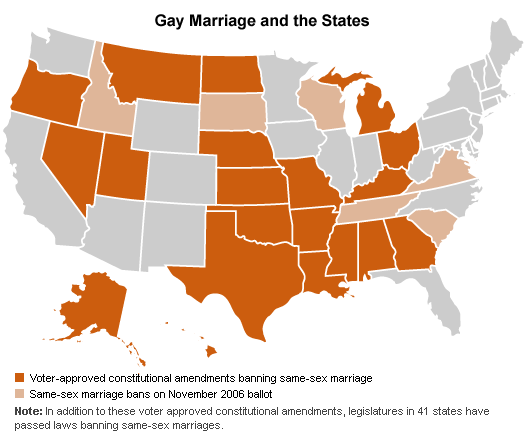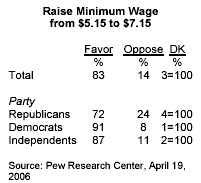by Paul Taylor
For more than a century, ballot initiative campaigns have been a way to make public policy at the state level, but in recent years some have also been launched with a secondary motive in mind: to influence the candidate races that share the same ballot.
 The most famous example came in 2004, when — legend has it — President Bush owed his reelection at least in part to ballot initiatives to ban same sex marriage in 11 states that helped draw social conservatives to the polls.
The most famous example came in 2004, when — legend has it — President Bush owed his reelection at least in part to ballot initiatives to ban same sex marriage in 11 states that helped draw social conservatives to the polls.
National Democratic leaders remain so taken with the purported success of that GOP electoral gambit that they recently announced their own copy-cat strategy for 2006.1 They are waging an effort to place initiatives on their favorite wedge issue — increasing the minimum wage — on ballots in a handful of states this fall. Meantime, Republicans, not to be outmaneuvered at their own game, are gearing up for another round of same sex marriage ban ballot initiatives this fall.
There’s just one problem with both gambits: to the extent that they are based on the notion that there was a widespread spill-over from the same sex marriage ban ballot initiatives onto the presidential race in 2004, they’re anchored more in myth than reality.
Here is a review of the relevant voting and turnout patterns:
Yes it’s true that in 2004, all 11 same sex marriage ban ballot initiatives were approved by voters — and by sizable margins, ranging from a 57% majority in Oregon to an 86% majority in Mississippi.
Yes, it’s true that Bush carried nine of the 11 states where the gay marriage bans were on the ballot in 2004. But it’s also true that, unaided by gay marriage ban initiatives, Bush won those same nine states in 2000.
Yes, it’s true that, in the aggregate, Bush increased his percentage of the vote in those 11 states by two percentage points between 2000 and 2004. But across all 50 states, he upped his percentage of the vote by three percentage points.
And yes, it’s true that turnout spiked in those 11 states by 18.4% between 2000 and 2004. But nationwide, turnout was up by nearly as much — 16%. And in Red America (the 31 states that Bush carried in 2004), turnout was up a bit more — 18.9%.
In short, toting up all these numbers, it seems safe to say that the 11 gay marriage initiatives had no across-the-board impact on the 2004 presidential race.
But hold on — that’s not quite the end of the story. Aggregate statistics can sometimes hide small but important anomalies, and in our state-based, winner-take-all Electoral College system, a modest blip in a single state can theoretically swing a close presidential race. Despite the voting patterns described above, the gay marriage issue might — might — have contributed to Bush’s victory in Ohio, which turned out to be the pivotal state of the 2004 election.
Ohio, Ohio, Ohio
 The gay marriage ban carried Ohio with 61% of the vote, while Bush eked out the Buckeye State with 51%, his smallest margin of victory in any major state. Had Bush not carried Ohio and its 20 Electoral College votes, he would not have won reelection.
The gay marriage ban carried Ohio with 61% of the vote, while Bush eked out the Buckeye State with 51%, his smallest margin of victory in any major state. Had Bush not carried Ohio and its 20 Electoral College votes, he would not have won reelection.
In a state contest that close, any number of factors are potentially decisive. However, one set of Ohio findings from the VNS exit poll is especially intriguing. Even though Bush improved his overall share of the vote in Ohio by just one percentage point from 2000 (50%) to 2004 (51%), he registered much bigger gains among three groups that strongly oppose gay marriage — blacks (Bush got 16% of the black vote in Ohio in 2004, up from 9% in 2000); those who attend church more than once a week (Bush got 69% of those votes in 2004, up from 52% in 2000) and voters ages 65 and older (58% in 2004, up from 46% in 2000).
Nationally, by contrast, his percentage of the black vote grew only modestly (by two percentage points) from 2000 to 2004, his percentage of the vote among more-than-once-a-week church goers by even less (one percentage point) and his percentage among older voters by 5 percentage points.
So even though the voting patterns across the 11 gay-marriage-ban states provides scant grist for the theory that the initiatives helped swing the 2004 presidential race, this closer look at Ohio — where (not incidentally) the Bush campaign invested heavily in get-out-the-vote activities organized in part through black and evangelical churches — suggests that the gay marriage ban initiative might have played a pivotal role, after all.
All of this, of course, lies in the land of conjecture. The same holds true for the Democrats’ notion that placing minimum wage initiatives on ballots this fall in states such as Missouri, Ohio, Arizona, Colorado and Nevada might swing some close congressional, senatorial or gubernatorial races their way. Or for the Republicans’ hope that gay marriage ban initiatives might help their candidates in states such as Idaho, South Carolina, South Dakota, Tennessee, Virginia and Wisconsin.


For information on candidate races in the 50 states, view a Stateline.org interactive map.
The Nature of Wedge Issues
 However, a number of things are already known about public opinion toward both the minimum wage and gay marriage issues that bear on their potential impact at the polls.
However, a number of things are already known about public opinion toward both the minimum wage and gay marriage issues that bear on their potential impact at the polls.
<ul >
- By an overwhelming margin (83% to 14%), the American public favors increasing the minimum wage by $2 from its current level of $5.15-an-hour, where it has been fixed since 1997. More than nine in ten (91%) Democrats support such an increase, but so do 72% of Republicans and 87% of independents.
- However, raising the minimum wage is a much more important issue to Democrats than to Republicans. Some 67% of Democrats rate it as a “very important” issue, while just 36% of Republicans do the same.
 There is also a partisan gap in the salience of the gay marriage issue, but it is not nearly as large. Some 43% of Republicans say gay marriage is a very important issue, compared with 31% of Democrats.
There is also a partisan gap in the salience of the gay marriage issue, but it is not nearly as large. Some 43% of Republicans say gay marriage is a very important issue, compared with 31% of Democrats.- Despite all the attention that political tacticians have paid in recent years to gay marriage as a wedge issue, it ranked dead last in importance among a list of 19 issues rated by registered voters in a June 2006 survey by the Pew Research Center for the People and Press. Education, the economy and health care topped the list; the minimum wage was in 13th place.
- In electoral politics, however, what often matters most in measuring an issue’s potential impact is not whether a great many people care about it, but whether even a relatively small number care about it enough to base their vote on it. Indeed, the classic “wedge issue” is one that draws more of one kind of partisan than another to the polls.
 Pew polling suggests that that sort of intensity gap may be present with the gay marriage issue. Among those who oppose gay marriage, 45% rate it as a very important issue. Among those who favor gay marriage, just 27% rate it that way. Those numbers, perhaps more than any others, help explain why — whatever impact the issue did or didn’t have on the presidential race in 2004 — some GOP tacticians are so eager to see gay marriage state ballot initiatives back again this fall. And why Democratic tacticians feel the same way about the state minimum wage initiatives.
Pew polling suggests that that sort of intensity gap may be present with the gay marriage issue. Among those who oppose gay marriage, 45% rate it as a very important issue. Among those who favor gay marriage, just 27% rate it that way. Those numbers, perhaps more than any others, help explain why — whatever impact the issue did or didn’t have on the presidential race in 2004 — some GOP tacticians are so eager to see gay marriage state ballot initiatives back again this fall. And why Democratic tacticians feel the same way about the state minimum wage initiatives.
Maps provided by stateline.org
Notes
1Edmund L. Andrews, “Democrats Link Fortunes to Rise in Minimum Wage,” New York Times, July 13, 2006.


